
Chameleons are the sweetest creatures. They are beautiful, fascinating, shy, and extremely docile. You would believe that they will make the perfect pets and you can hold them all day! But unfortunately, that’s not the case.
Chameleons don’t like to be held. They don’t like human interaction and love to be in their own space. However, there are a few species of chameleons who don’t mind perching on their humans for a few minutes.
So, let’s read more about the chameleons and which ones you can hold.
Table of Contents
Do Chameleons Like To Be Held?
Generally, chameleons don’t like to be held at all. For centuries, they have been living in the wild and they have adapted themselves to hide from any danger. They were never touched or handled by people.
Nowadays, people love to keep them as pets. However, they have evolved as species that were never touched, so they get stressed very easily. Note that stress is harmful to them and significant stress can also cost them their life.
Moreover, certain chameleon species become uncomfortable. So, they puff or hiss, or even change their color to black to show anger.
On the other hand, there are some species, who would come out to greet you, sit on your shoulder or hand, and even eat directly from your hand. Therefore, it all depends upon the type of species you have.
How To Hold a Chameleon Properly?
Gaining a chameleon’s trust is pretty hard. As we mentioned before, they are sensitive and shy and if you mishandle them, then they can easily get angry. They may not even let you handle them again.
So, we have a few steps for you to follow if you want to handle your chameleon.
Step 1: Move Closer
Move closer but don’t startle them. You can just sit around them for a couple of minutes so they become accustomed to your presence. You don’t want to startle them because that will cause stress.
Moreover, if you put your hand directly into their
Step 2: Offer Food
You can directly feed them with your hand by putting your hand in the
The panther chameleon in the video below is so comfortable that it even comes out of the enclosure during feeding.
Step 3: Make Them Comfortable
Gently move your hand into the cage again after they have eaten the first feeder insect. They will expect that you are giving them
Additionally, they may even come on your hand. If you see that they are comfortable, then you can pick them up with proper support.
Don’t pick them forcefully, rather let them come to you. If they are comfortable then they would stay on your hand for a longer period. But if they are not then they will make it clear by puffing.
Step 4: Provide Support
Don’t let your chameleon dangle in the air. They like to hold onto things and your hand is new territory. So, let them get comfortable and make sure your chameleon can grab your hand and fingers properly. They will probably freeze on your hand but that’s alright.
Additionally, you can also give them a very slight push on their back, basically, just touch them. They might understand this as a sign of moving forward and coming on your hand.
Moreover, if your chameleon has become accustomed to this habit, then you can even let them go from one hand to the other.
These steps are easy to do on a younger and smaller chameleon. However, if you have a larger chameleon, then you can also give them a branch to move on. If they are already a branch in their vivarium, then you can also offer them a flat palm under their chin to pick them up.
Step 5: Back Into The Tank
When it’s time to put them back in their vivarium, then gently lower your hand into the
You will see that your chameleon will probably grab the first branch it can reach and climb up the plant or tree in the vivarium.
You can also watch this video to get a better understanding of how you can handle a chameleon.
What To Avoid While Holding a Chameleon?
If you follow the above steps precisely, then you will have no problem handling the chameleon. But if you steer away, then it could turn problematic for both you and your chameleon instantly.
That’s why we have a couple of pointers for you to know what things you should avoid while holding a chameleon.
Don’t Startle
Never startle your chameleon as it can come under great stress. The sudden movements in their vivarium will scare them and as a defense mechanism, they can even bite you. Always approach your chameleon or its
Don’t Pet
Don’t pet them instantly when they climb up on you. Give them some time to get comfortable with your body. Let them explore a bit and then when you think there is some ease in their movements, then place your finger on them to check their reaction.
If the reaction seems fine, then you can place your hand on them slightly. Always look if your pet is comfortable in something or not.
Don’t Push
Don’t push them to climb up on you. Let them come to you naturally as that way they will not be as tense. Moreover, if in case, they don’t come to you, don’t pull them up from their belly.
In extreme cases, if you hurt a chameleon, instead of huffing, they will bite you. Chameleons have sharp teeth, so it’s better to not be in their bad books.
Additionally, don’t chase them around in their vivarium if they don’t come to you. Respect their boundaries.
Don’t Approach From Above
Chameleons have a natural instinct and find anything larger than them to be a predator. Moreover, the birds usually pick the chameleons up from the branches.
Therefore, if you approach from above, they will treat you as a predator and will turn defensive. They can jump on you and bite you.
Additionally, don’t approach them from behind as well as it will have the same result. You should always approach them from the front, so they can understand your intentions.
Don’t Hold Two Chameleons Together
Never keep two chameleons in a single vivarium or in your hand at the same time. Chameleons are usually very territorial, so if they find another chameleon on your hand or on the branch then they will fight it off. They can even try to eliminate the danger.
How Do You Know if Your Chameleon Feels Uncomfortable?
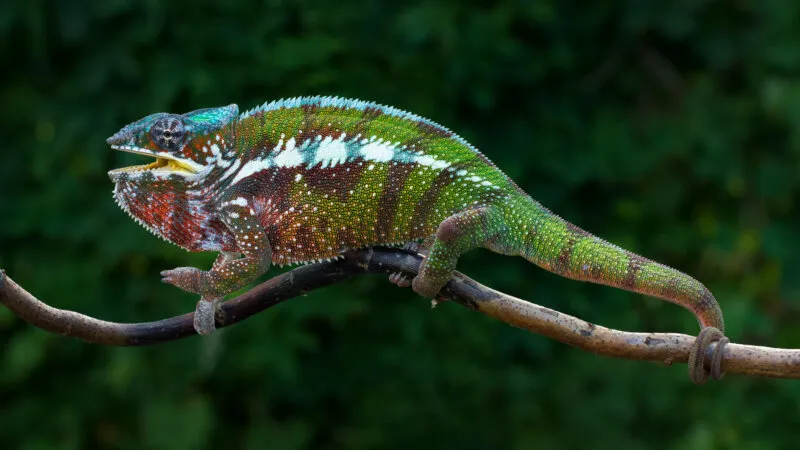
Chameleons are great communicators if they feel uncomfortable in any situation. If you mishandle them, go against their will, or pick them up in the wrong manner, then they will get uncomfortable.
It’s always good to give them space in such situations and leave them alone. They’ll work better this way.
Here are some of the ways through which they will communicate their discomfort:
Gaping
Although a chameleon gapes in different situations such as when it is too hot or is not able to breathe properly. But in a situation where it is uncomfortable with the way you handle it, then it is showing you that it will defend itself.
Gaping means opening their mouth, so you can also see their sharp teeth. It is feeling threatened and is under stress, hence it will gape.
Puffing
Chameleons puff under stress or fear and they make their bodies almost double the size to make themselves look larger. Moreover, they can puff their throat and turn bright. This can startle people and they back off.
Running Away
Chameleons have a defense mechanism of fight or flight. If they are not in the mood to fight you or gape at you, then they will run away from the situation. If in case you push them too much to perch on your hands, they will hide in a corner to avoid it. This is a clear signal for you to not approach them again.
Biting
This is their last resort if nothing else works. Sometimes, the owners really push the chameleons to become friendly with them or try to pet them. This usually happens when you have not researched about them before getting them as a pet.
Their first instinct is always to gape or hiss at you, if you continue to repeat your actions, then they can puff, and ultimately, they will bite.
Turning Black Or Showing Bright Colors
It’s very easy for a chameleon to get stressed at the slightest inconvenience. Although they also turn black when they are cold to absorb all the heat available, but it is also a sign of discomfort. If they are feeling stressed, threatened, or if they fear something then, they turn black.
Also, chameleons show very bright colors if they are startled. So it is not just the dark colors you should be aware of.
Hissing
Chameleons will hiss at you if you approach them in the wrong manner or startle them. Under stress, you can experience hissing with puffing as well. If they are injured or are in pain, then again they hiss.
Which Chameleon Species Like To Be Held?
If you want to get a chameleon that is naturally more calm and tolerant when it comes to handling, you should get an Oustalet chameleon, Rudis chameleon, Jackson’s chameleon, or a Parson’s chameleon. Other chameleon species are known for being more aggressive or fearful.
For instance, a veiled chameleon and panther chameleon can be very aggressive. The latter can only tolerate you handling them for just a couple of minutes but that quite rarely.
The former, on the other hand, are extremely territorial, hence, even a human is a threat to it. You can still handle these chameleons, some of them might even be okay with it, but you need to accept the fact that some species are just less likely to be okay with handling than others.
So, if you want a pet that is naturally okay with being held handled, have a look at the chameleons below.
Info: Pierre had a very tame panther chameleon back in the day. It came to the the front of the enclosure whenever Pierre was near and as soon as he opened the doors of the terrarium, his chameleon almost jumped on his hand. The reason for that was that the chameleon breeder handled the chameleons right from the start when they were babies. So walking on humans was totally normal for these chameleons.
Oustalet Chameleon/ Malagasy Giant Chameleon (Fucifer oustaleti)
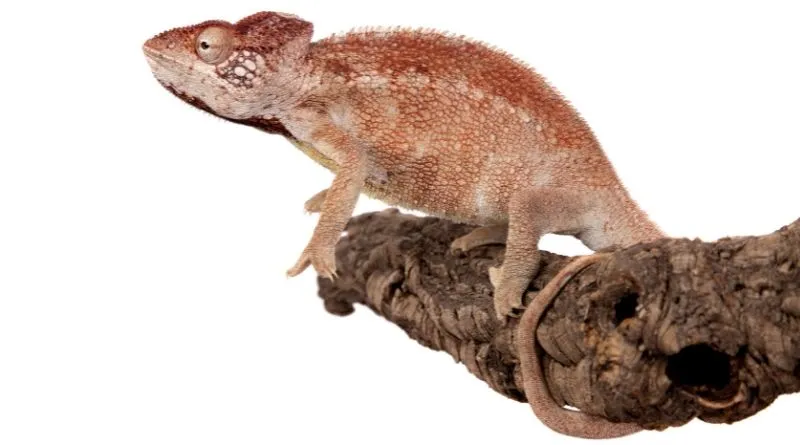
The Oustalet chameleon is a friendly one and will let you hold it without any issue. It’s better to get them at a young age so they become more familiar to you. They will let you hold them and won’t lose their calm that quickly.
Still, they are big, so be careful when you handle an adult Oustalet chameleon that you don’t know well. Always watch the body language, this way you can see early if your chameleon gets upset or stressed out.
Rudis Chameleon (Trioceros rudis)
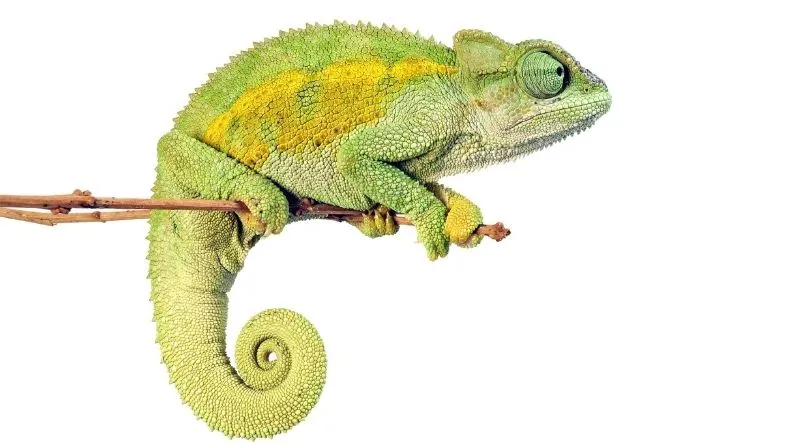
The Rudis chameleon is a fairly calm and docile chameleon and doesn’t mind if you hold it for a couple of minutes. But if you overdo it then they want to be left alone.
Keep in mind, just because Rudis chameleons tolerate handling better than other chameleons, it doesn’t mean that it is really okay with it. Always make sure that your Rudis chameleon shows relaxed body language when being handled. If it doesn’t, keep the handling session short.
Jackson’s Chameleon (Trioceros jacksonii xantholophus)
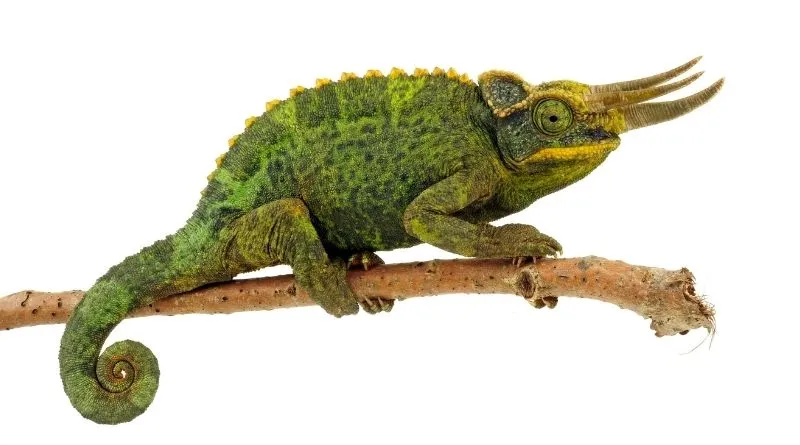
The Jackson’s chameleon is probably the most docile of all three. Although they are not playful they will entertain your need to hold them but only for a couple of minutes.
Just like the Rudis chameleon, Jackson’s chameleons are relatively laid back, they are smaller, less dangerous than bigger chameleons, and tolerate handling better but you still need to make sure that you don’t stress them out.
Parson’s Chameleon (Calumma parsonii)
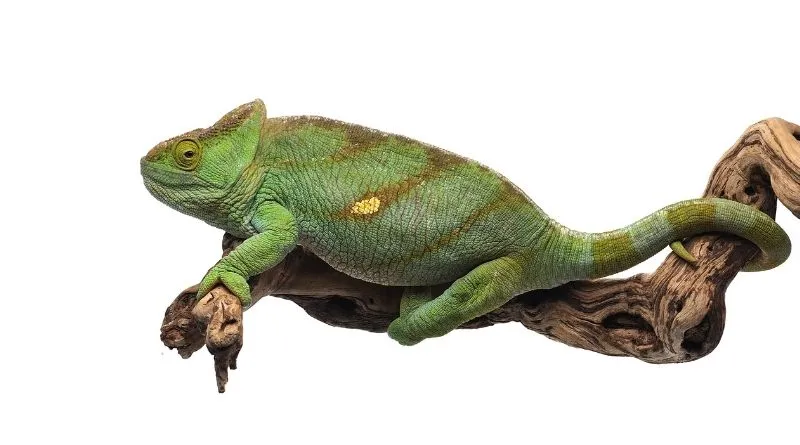
Parson’s chameleons are often said to be gentle giants. However, take this with a grain of salt. Not all chameleons will tolerate handling no matter the species, and if you’ve got a parson’s chameleon that doesn’t want to be handled, you might have a problem.
Just like the Oustalet chameleon, Parson’s are big chameleons and they can do some damage when they bite and it will definitely hurt more than a bite of a Jackson’s chameleon or a Rudis chameleon.
How Long Should You Handle Your Chameleon?
| Chameleon | Temperament | Time |
| Rudis Chameleon | Calm and docile | 20 minutes a week |
| Jackson Chameleon | Docile but not playful | 10-20 minutes a week |
| Oustalet Chameleon | Friendly yet shy | 10-20 minutes a week |
| Parson’s Chameleon | Gentle Giant | 20 minutes a week |
It is important to know that you can hold any chameleon if you handle them nicely and win their trust. It’s all about respecting them and their space. Each species of chameleon does not like to be held for a long period as it will cause them stress.
But these 4 chameleon species will still react less than the others.
What Happens if You Hold a Chameleon Against Its Will?
You should always respect your pet’s wishes and if it is uncomfortable, then you should never push the situation. But if you are holding it against its will, then here are a couple of things that can happen:
1. Irritation
As explained before, chameleons are shy and docile creatures and if they are bothered even a bit then they can easily get irritated. The irritation can result in puffing, hissing, and biting.
2. Stress
Stress is the worst thing that can happen to a chameleon. The slightest distress like handling them wrong or picking them up against their will exhaust them. Slight situations such as a dog running or a cat watching it closely, or even a bird flying can trigger stress.
But until and unless they are not touched, they will remain fine. But if you touch them against their will then they will gape, change their color, and hide in the low and dark places. If the stressor is not eliminated then extreme stress can cause their death.
Hence, you must understand the signs that your pet is showing otherwise it can cause irreversible damage. Moreover, for the first few times, if you hold them, they can still retain their calm and tolerate, but if it goes on regularly, then they will retaliate.
Even the most docile of all chameleons have bitten their owners due to extreme stress. There are different types of stress but the one with human interaction is Emotional Stress.
Others include a stress spike on seeing another chameleon or a dog; external physical stress in which the outside temperature affects them.
You should know about these stress levels and how to handle each stress type individually. In turn, this will help you win over your chameleon’s trust as well.
How To Get a Chameleon Used to Being Handled?
If you want to hold your chameleon, you might want them to get used to you handling them. Given below are a few tips that would help.
Tip 1: Be Patient
It takes months sometimes to win their trust and let them come to you. Some chameleon species are rather friendly and won’t mind coming to you within a week of their arrival.
Hence, a juvenile chameleon is the best choice for you because you can mold them slightly to your needs.
They can get comfortable with your touch and being held but adult chameleons will never entertain this. So you have to be patient enough and not rush the process.

Tip 2: Pay Attention to Them
Bear in mind that handling a chameleon is not about you but about the pet. If they are not comfortable with something, they will communicate with you.
Pay attention to their signs, if they seem defensive at any time when you are trying to pick them up, then don’t move your hand.
The moment they think that you’re not there to harm them, they’ll perch on you.
Tip 3: Build Trust
Building trust helps in a lot of situations. If you want to take your pet to the vet, then they require you to hold them or if they want to move to a certain tree, they’ll trust you to carry them. That’s why you have to remain patient and build their trust in you.
Remember that chameleons see you as a predator, that’s why they get scared of you easily.
Tip 4: Feed Them Treats
Treats are an absolute favorite among pets and this is the best way to get them comfortable. Start feeding them in their vivarium, then after a few days, you can keep the worm or other treat on your hand. They’ll come and eat from there.
Final Thoughts
Chameleons are sweet and we adore them for their different colors. We expect them to behave like a pet and we try to pet them to like us. But the case is entirely different with chameleons as only a few of them are comfortable with this.
Always know what your pet wants and never go against their will because it can affect you physically. We hope this article helped you in understanding chameleons a bit better.
- Enchi Ball Python: A Unique and Stunning Morph of Python regius - March 27, 2025
- Emerald Tree Monitor: The Enigmatic Green Guardian of the Rainforest - March 26, 2025
- The Egyptian Cobra (Naja haje): A Fascinating Serpent - March 25, 2025
